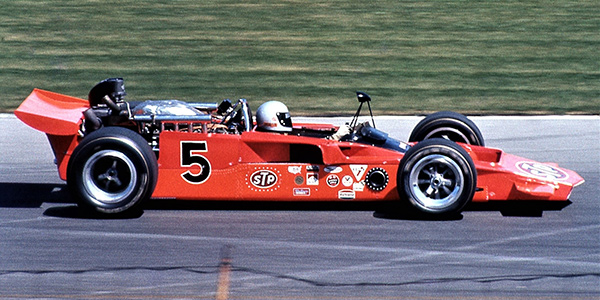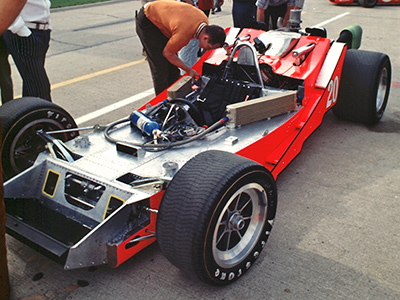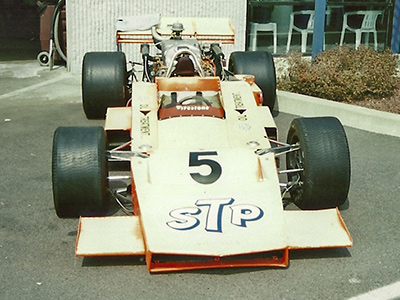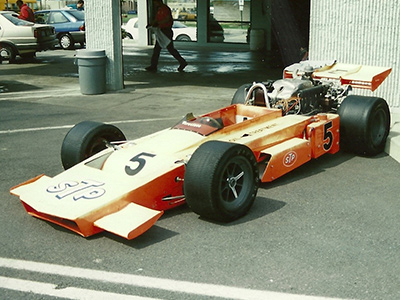McNamara T501 car-by-car histories

Mario Andretti in the STP McNamara 501 at Milwaukee in August 1971. Copyright Paul Castagnoli 2022. Used with permission.
The second McNamara Indy car design was lower and lighter than the 1970 model, but suffered from chassis flexing and driver Mario Andretti struggled with it at the Indy 500. The relationship between STP and McNamara quickly came to an end.
Designer Jo Karasek's new McNamara T501 was a quite different design to his preceding McNamara T500, with a wide, flat, straight-sided monocoque and Lotus-style rocker-arm front suspension. The weight was expected to be between 1380 and 1400 pounds, compared with 1460 for its predecessor, the weight reduction having been achieved through the use of titanium in the hubs, gearshift lever and some of the bolts. The resulting car was three inches longer than the T500, at 99 inches, and four inches lower. As well as the suspension changes, Popular Mechanics reported that it was fitted with inboard rear brakes, which it referred to as "a first on championship cars", although they were also fitted to the 1971 McLaren M16. One of the major design limitations of the car was the use of the very wide Ford V8 engine, which compromised the aerodymanics. Karasek used three-tiered spoiler on the sides of the T501, but the car was unable to match the speeds of cars using the more compact Offenhauser engine. Karasek won the Society of Automotive Engineers' Louis Schwitzer Award for design innovation on the T501.
Andretti had considered leaving after the 1970 season, but was convinced to stay when his former mechanic Jim McGee was lured from Clint Brawner's team to replace Vince Granatelli as Andretti's chief mechanic for 1971. Vince Jr was assigned as mechanic on the second STP car, for the highly-rated Steve Krisiloff. It became evident that the deal also involved Andy Granatelli staying out of the Andretti-McGee garage. The new car was being completed in Lenggries in February, and it was ready for testing in the US in early March. Andretti drove the prototype at Phoenix and Trenton while a new car was built for him to drive at the Indy 500. A third car was also built for the Speedway after Krisiloff's 1968 Hawk was wrecked at Trenton. Andretti qualified ninth at the Speedway, his worst ever starting position in the 500, and later commented that the car was flexing badly, making it difficult to set up. The race went no better as Krisiloff's McNamara dumped oil on the track when its engine failed and Andretti hit the oil and spun into the wall.
Rumours persisted through the summer that Andretti and McGee would be leaving STP to join a new team set up by John Mecom. However, Andretti stayed to drive the one intact McNamara T501 and STP absorbed Grant King's team to run his two 1970/71 Kingfish as #20 and #40 for Krisiloff and Larry Dickson. Andretti's Indy 500 car was rebuilt in time for Pocono with completely revised aerodynamics, along McLaren M16 lines, and proved more competitive. By mid-July, a completely new car, intended for Andretti to use at the Ontario 500, was being constructed by Chuck Looper, Wayne Guyer and McGee at Grant King's shop. This retained the McNamara's suspension but had a significantly strengthened monocoque to overcome the chassis flexing the team had experienced at the Indy 500. The fuel tanks and oil cooler were mounted lower in the chassis to lower the centre of gravity.
If you can add to our understanding of these cars, or have photographs that we can use, please email Allen at allen@oldracingcars.com.
New for Mario Andretti as the #5 STP entry at the opening race of the 1971 season at Phoenix. Also raced by Andretti at Trenton, then kept as an unused backup car for the Indy 500, and then raced by Andretti at Milwaukee in June. Andretti finished well down the field at Milwaukee after the engine would not restart during a pit stop, and to add to Andretti's growing dislike of the car, it became so hot in the cockpit that his fingers required medial treatment. This car was not raced again. It is possible that it was dismantled to provide parts for the 'new' car built for the Ontario race.
Driven by: Mario Andretti. First race: Phoenix International Raceway (R3), 27 Mar 1971. Total of 3 recorded races.

Mario Andretti's STP McNamara 501 at the 1971 Indy 500. Copyright Paul Castagnoli 2022. Used with permission.
New for Mario Andretti as the #5 STP entry at the 1971 Indy 500. Andretti qualified ninth with a speed of 172.612 mph. The car was damaged during the race when Andretti spun on oil and hit the barrier but was rebuilt extensively by chief mechanic Jim McGee in time for Pocono in July. Andretti qualified fifth and finished fourth at Pocono, then also raced this car at Michigan two weeks later, where he qualified third but retired, and at Milwaukee in August. Andretti used a newer long-chassis car produced by McGee at Ontario, but returned to the Pocono car for the Trenton race in October. He took second place at Trenton, the best result by this model of McNamara, but then drove the Ontario car at Phoenix. It is possible that this Pocono car was the intended #20 for Steve Krisiloff at Phoenix, which he crashed in pre-race testing. The 1971 McNamaras were not used again, and McNamara prepared for the 1972 Indy 500 was a 1970 car. Subsequent history unknown.
Driven by: Mario Andretti and Steve Krisiloff. First race: Indianapolis Motor Speedway (R5), 29 May 1971. Total of 4 recorded races.

The #20 STP McNamara T501 of Steve Krisiloff during practice for the 1971 Indy 500. Copyright Rex Miller 2022. Used with permission.
This car was put together quickly for Steve Krisiloff to drive at the 1971 Indy 500 as the #20 STP entry after his Hawk was wrecked at Trenton. Krisiloff's chief mechanic Vince Granatelli Jr, Andy Granatelli's son, built up the car in time for the first day of qualifying, and although Krisiloff practiced, there was no time for a qualifying attempt. Krisiloff practiced at over 171 mph over the next week but crashed on the Saturday of the last weekend of qualifying. The car was rapidly rebuilt in just five hours and he qualified 27th with a speed of 169.835 mph, making it Vince Jr's first Indy 500 as a chief mechanic. Krisiloff was eliminated from the race when the McNamara's engine blew and deposited oil on the track, which unfortunately caused his teammate to spin into the wall. Krisiloff's car was parked on the infield and was later badly damaged when it was hit by Mike Mosley's Eagle. On 22 June, Andy Granatelli announced that this car could not be repaired, and that he had bought Grant King's two 1970/71 Kingfish for Krisiloff and George Follmer to drive for the rest of the season. This car's surviving componentry may have been used in the new longer McNamara built by Jim McGee and his team that appeared at Ontario.
Driven by: Steve Krisiloff. First race: Indianapolis Motor Speedway (R5), 29 May 1971. Only one recorded race.

The McNamara 501 'Ontario car' at an Andretti Hannah Auto Wash in Allentown, PA in 1995. Copyright Jim Stephens 2022. Used with permission.

The McNamara 501 'Ontario car' at an Andretti Hannah Auto Wash in Allentown, PA in 1995. Copyright Jim Stephens 2022. Used with permission.
The STP team produced a heavily revised McNamara for Mario Andretti to drive at the California 500 at Ontario. The car was said in press reports to be the longest Indy car in history at 184 inches, "33 inches longer than the car from which it was rebuilt". Andretti qualified eighth. It was this Ontario car that Andretti revved noisily on the White House lawn when President Nixon invited a number of auto racing luminaries to Washington on 21 September. Photographs show that he also raced this car at Trenton in early October and at Phoenix three weeks later. It was not seen at a race track again but appears to have become an STP show car. In 1977, STP loaned a number of their show cars to different institutions, and this car was loaned to the Briggs Cunningham Automotive Museum (Costa Mesa, CA). That museum closed in 1987 and most of the collection was acquired by the Miles Collier Collection in Florida. However, what happened to the McNamara during this time is unknown. It was on display at an Andretti-Hannah Auto Wash in Allentown, PA in 1994, and was then photographed in the Don Garlits Drag Museum in October 2005, when it had a board saying it was on loan from, or had been donated by, STP. More recently, the car was loaned to another museum, but in 2022 it was in the process of returning to the Garlits museum. In December 2024, the car was on display in the Motorsports Hall of Fame & Museum at Daytona Speedway, its board saying that it was on loan from the Garlits museum.
Driven by: Mario Andretti. First race: Ontario Motor Speedway (R10), 5 Sep 1971. Total of 3 recorded races.
The end
On 26 May, a few days before the 1971 Indy 500, McNamara took STP to court to try to retrieve payment due for materials and services, by putting a restraining order on the Speedway from paying any prize money to STP. When both cars exited the race early, any chance of repairing the relationship was gone and the end came for McNamara Racing very quickly and quite tragically. McNamara's wife Bonnie died unexpectedly in June 1971 and with Granatelli aggressively disputing McNamara's claim that any money was outstanding, McNamara Racing was soon put into liquidation.
In June 1971, just a fortnight after the Indy 500, The American Consumers Union issued a report saying that STP was "a worthless oil thickener that may violate a new car's warranty". Despite Andy Granatelli's best effort to fight back, the "snake oil" association stuck, and STP shares tumbled from $53 the day before the report's publication to just $3.75 two years later. In an attempt to bolster sales, Granatelli diversified STP's marketing expenditure away from the Indy 500 and for 1972 arranged to sponsor both the March F1 team and a stock car driver, Richard Petty, a relationship that would last longer at STP than Granatelli would.
Andretti was not staying for 1972, as had been obvious for a while, and he joined the Parnelli team to drive a third car alongside Al Unser and Joe Leonard. Andy and Vince Granatelli had to start again from scratch with the Indy 500 and would buy Lola T270s for 1972. Vince Granatelli Sr was put back in charge, so it would be another poor season.
How many McNamara T501s were built?
After the prototype car that was unveiled in March was raced by Andretti at Phoenix and Trenton, two new cars were built for the Indy 500, where it was mentioned that the "old No 5" (i.e. the prototype) was present but did not get on track. If we call the prototype '1', the two Indy 500 cars were '2' and '3', both heavily damaged during the race. As Krisiloff's car was built up rapidly after Trenton and arrived at the Speedway after Andretti's new car, it is reasonable to call Andretti's '2' and Krisiloff's '3'. We know Andretti then used '1' at Milwaukee, as it was reported to be the car he used at Trenton. For Pocono, a rebuilt car was produced which press reports said had been rebuilt from Andretti's Indy 500 wreck (i.e. '2'). Then a much longer car was built for Ontario, which is therefore logically '4', but it is distinctly possible Jim McGee and his crew had started from Krisiloff's Indy 500 wreck and fabricated a new monocoque perhaps using existing bulkheads. STP and McNamara Racing had fallen out by this time, so it is highly unlikely that another monocoque had been provided since the Indy 500. Either way, the Ontario car deserves to be seen as a new car. After Ontario, Andretti mentioned in the press that he was going to race the Pocono car at the last two races. However, Russ Thompson found a picture of Andretti at Phoenix showing him driving the Ontario car. So that leaves the identity of the car wrecked by Krisiloff in testing at Phoenix in October as a puzzle. As Andretti used the the long-chassis Ontario car ('4') at Phoenix, not the Pocono car ('3') as newspaper reports had predicted, it is possible Krisiloff was driving the Pocono car and wrecked it in that incident. Alternatively, he could have been using the original prototype ('1').
The many serious accidents - two at Indy and Krisiloff at Phoenix - and the split from the McNamara operation after the Indy 500 would suggest that the STP team only had one or two T501s left at the end of the season, the Ontario car and perhaps one other. Neither was seen in 1972, when STP used one of the 1970 cars as a backup at the Indy 500. The Ontario car has been seen on display a few times since 1971 but nothing is known of any other surviving T501.
Sources
My thanks to 'Mac' McNamara for his recollections, to marque expert Prof Dr Peter Schroeder, to Simmo Iskül and 'gbl' for their help identifying the McNamaras used by STP between 1970 and 1972, to Russ Thompson for information on the final Phoenix race of 1971, and to Paul Castagnoli, Jim Stephens and Rex Miller for their photographs. Also of significant use were Popular Mechanic May 1971 p85, and George Moore in the Indy Star 25 July 1971 Section 4, page 6 where he described the new car being built for Ontario. Prof Dr Peter Schroeder's book 'McNamara Racing' (published by VIEW GmbH, Bonn, 2015; ISBN 978-3-945397-03-9) is highly recommended and tells the story in more detail and with greater insight than can be told here.
If you can add to our understanding of these cars, or have photographs that we can use, please email Allen at allen@oldracingcars.com.
These histories were last updated on .